There’s a typo in the title. If you go back to the original source (in french), they actually retain 79,5 % of their original efficiency, so even better than the article’s title would have you believe.
I guess we can blame the French’s confusing number system for that.
People seem to be angry at you for not knowing how the French count. My condolences. I found it funny tho. Have un upvote
Well, I DO know how the French count and compared to English it IS highly confusing. You can hardly convince me that saying “Four times twenty and ten” is as straight forward as saying “Nine tens”.
And just to be clear: I’m not some Yankee or Brit with a superiority complex, no, I am German, and we have our own shitty version of this: Instead of moving along the digits from highest to lowest, as in “Four hundreds and two tens and nine”, we do “Four hundred and nine and two tens”.
Wow, it’s like US uses metric system for counting and y’all do “imperial counting”
It indeed is.
And don’t even get started with Danish.
It supposedly comes from originaly counting in base 20 ( a.k.a : vigesimal system) in some proto-european language. There are traces of it in breton, albanese, basque and danish for example. Even in english, there is a reminiscence of vigesimal, in the “score”, see for example Lincoln’s Gettysburg Address “Fourscore and seven years ago…” means 87 years ago.
But Basque isnt an Indo-European language its a Paleo-European isolate. Cultural mixing not with standing.
What the hell is wrong with y’all?
It’s less confusing if you think of 70 and 90 as separate words without trying to analyze what their constituting words mean.
But etymologically, sure, it makes no sense.
The dude was saying people are angry at you because they don’t understand, not that you dont understand.
deleted by creator
Instead of moving along the digits from highest to lowest, as in “Four hundreds and two tens and nine”, we do “Four hundred and nine and two tens”.
English is less consistent, going from nine-teen to twenty-one. German stays consistent with its lower two digits.
From 11 to 19 is always kind of weird in many languages. In Italian you go from essentially saying “one-ten” “two-ten”…“six-ten” to “ten-seven” “ten-eight” “ten-nine”. Then it goes in like in English. Why? No reason ¯\_(ツ)_/¯
Soixante-quinze virgule neuf vs soixante-dix-neuf virgule cinq.
Easy peasy!
Edit: it wasn’t easy peasy.
Cinq
Ouch lol yeah thanks.
That was close enough!
I wish I could give fourtwentytennine upvotes to help
It supposedly comes from originaly counting in base 20 ( a.k.a : vigesimal system) in some proto-european language. There are traces of it in breton, albanese, basque and danish for example. Even in english, there is a reminiscence of vigesimal, in the “score”, see for example Lincoln’s Gettysburg Address which famously starts with : “Fourscore and seven years ago…”, meaning 87 years ago.
As a frenchman who always found quatre-vingt weird but never bothered to find out why, thanks :)
Mais je t’en prie :)
In English is this why we say fifteen instead of tentyfive?
I’m four-twenties-ten-nine percent sure that French counting is not confusing
No you can’t, because the source has written it in the usual hindu-arabic numerals as 79,5 and not as “soixante-dix-neuf virgule cinq”, you don’t need to pronounce the numerals to copy them.
It’s still a good joke!
Yes but is that the average panel, oraverage of still a working panels?
Careful using the word efficiency there, as it has a different meaning when talking about solar panels - it indicates how much energy the panel can extract from the light hitting it. The best modern panels you can buy are below 25% efficient, and since these are from the 90s they were probably about half that when new.
Wow, imagine where we’d be if Oil and Gas hadn’t convinced almost everyone that solar was never going to work well.
Imagine where we’d be if people didn’t automatically think nuclear power=Homer Simpson
Is it too much to ask for people to not get their political opinions from cartoons?
Instructions unclear, politics informed by WW2 doctor Seus propaganda.
The great thing about nuclear power is that the real cost only comes after the power has been generated. How do you store the spent fuel cells and what do you do with the reactor when it can’t be used anymore. Just before that happens you spin the plant into its own company. When that company goes bankrupt the state needs to cover the cost, as it isn’t an option to just leave it out in the open.
Privatise profit communalism cost.
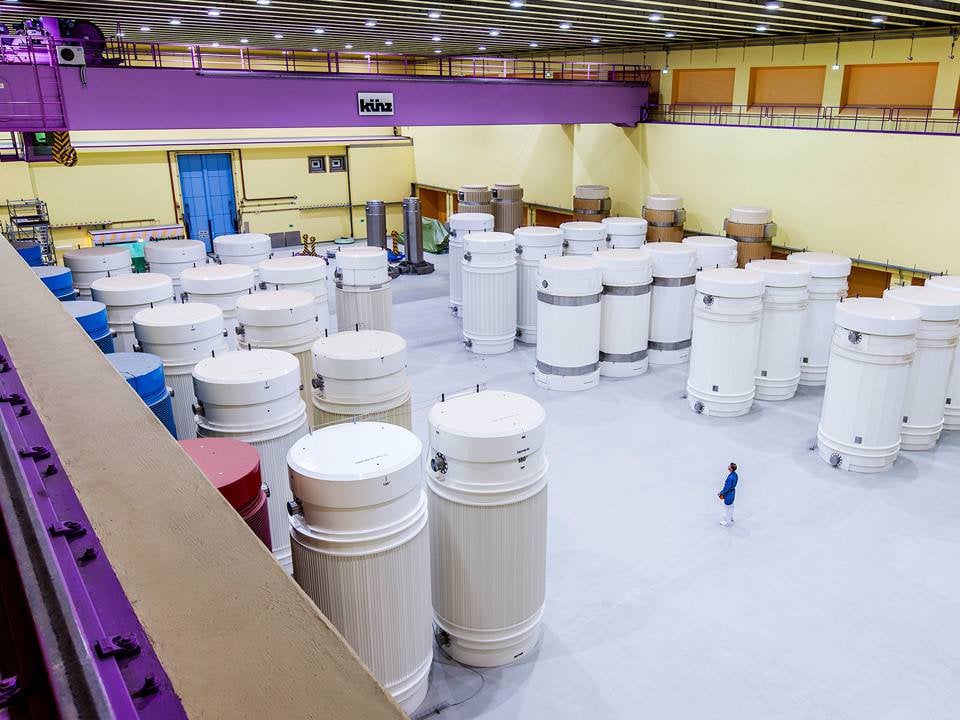 Here’s all of Switzerland’s high level nuclear waste for the last 45 years. It solid pellets. You could fit the entire
Here’s all of Switzerland’s high level nuclear waste for the last 45 years. It solid pellets. You could fit the entire world’sUS’ waste on a football field.It’s not the greatest challenge mankind have faced.
Also want to point out, most of that is container, not spent fuel. The safety standards are so ridiculously high that they basically guarantee zero risk.
More people (per plant) are exposed to elevated levels of radiation due to coal power, and that’s not even including the health risk of all the other shit they release
According to Our World In Data (which claims to use the Energy Institute’s Statistical Review of World Energy from 2023 as a data source), that waste is from producing around 70 TWh each year:
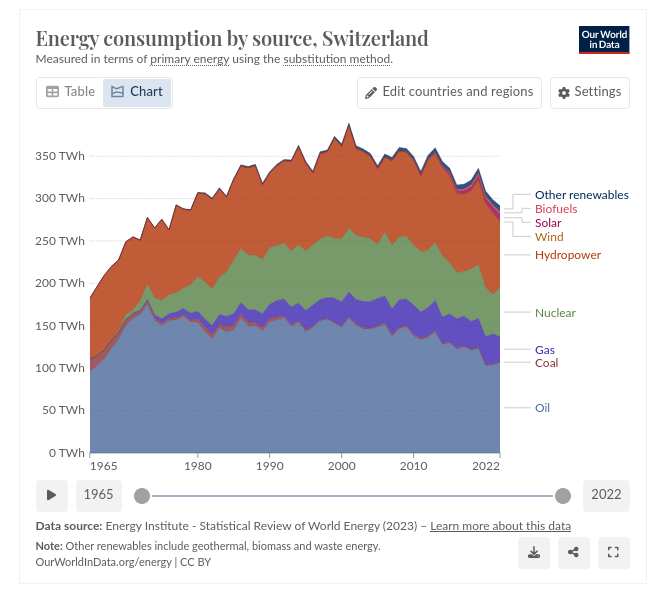
That only covers around a third of Switzerland’s energy consumption over those years. Furthermore, Switzerland is a small mountainous country with decent access to hydropower (making up around a third of its needs over the same years). They are not necessarily representative of the waste that would accumulate from a more agressive switch from fossil fuels to nuclear across the world (which is what we’re talking about, if I’m not mistaken).
France is about 10 times larger in surface area and according to the same source, consumed/produced over 1,000 TWh of nuclear energy each year:
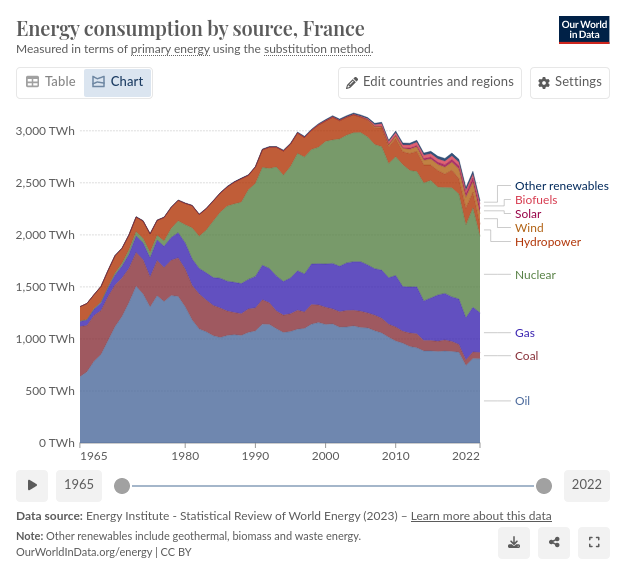
And officially has still has no place to put the high-energy waste (source - in french), leaving it up to the plant’s owners to deal with it. There is an official project to come up with a “deep” geological storage facility, but no political will seems musterable to make that plan materialize beyond endless promises.
I should mention that I’m not super anti-nuclear, and I would certainly rather we focus on eliminating coal and oil power plants (and ideally natural gas ones as well) before we start dismantling existing nuclear reactors that are still in functioning order.
That being said, there are other problems with nuclear moving forwards besides waste management. The main one that worries me is the use of water for the cooling circuits, pumped from rivers or the sea. Not only do open cooling circuits have adverse affects on their surrounding ecosystems, as the planet gets warmer and the temperature swings during the hotter seasons become more pronounced, the power plants will become less efficient. The water going in will be at a higher temperature than it is today, and thus will absorb less energy from the nuclear reaction itself.
Overall, I don’t trust our current collective responsibility as a species to manage our current forms of nuclear production. Russia sent its own troops into the Chernobyl Exclusion Zone to dig trenches in contaminated soil last year, and they allegedly recognized last week that the Zaporizhzhia power plant is now “unsafe to restart” because of the military activity in the region.
The world has not experienced generalized warfare with nuclear power plants dotting the countryside; WW2 ended around a decade before the first nuclear power plants were up and running in the USSR, the UK, and the USA.
Not to mention how few European countries have access to uranium on their own soil/territory. Of course, most of the rare earth metals used in photoelectric panels and windmills aren’t found there either, but as least with “renewables” they are used once to make the machinery, not as literal fuel that is indefinitely consumed to produce power.
I don’t know enough about thorium-based reactors nor molten salt-based reactors to go to bat for them instead, but they seem like a more promising way for nuclear to remain relevant.
France made a record year last year, with 320TWh of nuclear power produced for a total of 434 TWh of electricity, while being the top exporter of electricity of Europe.
I don’t know how they got to 1000TWh of nuclear a year, I suspect weed.
I don’t think solution for storage would be a problem if politicians had more of a backbone with deciding a place for storage, and I frankly don’t see a future without fossil fuels where nuclear doesn’t play a key role. All of the US’ nuclear waste could fit on a football field 3 meters tall. We got space for it.
As for energy security. Canada is a massive producer, and NexGen Energy is sitting on a massive deposit. Most utilities store ~4 years of material on site, and the fact it’s so easily stored for many years is why Japan invested heavily in it in all those years ago. I don’t think access to uranium is much of a concern.
and I frankly don’t see a future without fossil fuels where nuclear doesn’t play a key role
I think the anti-nuclear idiots are, well, idiots, but I disagree with you here. I think the idiots have successfully blocked nuclear long enough that it’s just more economical to go full renewable + storage. Yeah, we should have had nuclear 50 years ago and would probably be looking at a much more habitable planet, I fully agree. But I think the ship has sailed.
In Germany, we’ve got a location with 47,000 cubic meters: https://www.bge.de/en/asse/
That requires some pretty tall stacking on that football field. Or I guess, you’re saying if you’d unpack it all and compress it?Also, we really should be getting the nuclear waste out of said location, since there’s a known risk of contamination. But even that challenge is too great for us, apparently.
Mainly, because we don’t have any locations that are considered safe for permanent storage. It’s cool that Switzerland has figured it out. And that some hypothetical football field exists. But it doesn’t exist in Germany, and I’m pretty sure, Switzerland doesn’t want our nuclear waste either.we don’t have any locations that are considered safe for permanent storage
I’m gonna hazard a guess that the “consideration” was not from actual scientists but rather activist homeowner groups in every potential site.
NIMBYism and nuclear, name a more iconic duo
I mean, can you blame them? Why would anyone want toxic waste in their backyard? Not to mention that the search is mainly conducted by companies, which have a vested interest in not making all the issues transparent.
Having said that, I am not aware of the ‘scientists’ coming up with good suggestions either. Gorleben got hemmed and hawed around for the longest time, but its selection process was non-scientific from the start.
It’s genuinely not easy to find a location where anyone would be willing to claim that it will remain unaffected by geodynamic processes for millions of years. And we don’t have a big desert or some other unpopulated area where you could chuck it without political opposition, when it’s not 110% safe to do so.
I mean, can you blame them?
Yes. I do it a lot.
Why would anyone want toxic waste in their backyard?
It’s not toxic, nor is it in their backyard.
Not to mention that the search is mainly conducted by companies, which have a vested interest in not making all the issues transparent.
What issues?
It’s genuinely not easy to find a location where anyone would be willing to claim that it will remain unaffected by geodynamic processes for millions of years.
In Germany, we’ve got a location with 47,000 cubic meters: https://www.bge.de/en/asse/
Read your link: 47 000m³ of low and intermediate radioactive waste.
Low radioactive waste is objects (paper, clothing, etc…) which contain a small amount of short-lived radioactivity, and it mostly comes from the medical fields, not nuclear plants, so even if you phase out of nuclear, you’ll have to deal with it anyway.
This waste makes up for the vast majority (94% in UK for example) of the nuclear waste produced, and you can just leave it that way a few years, then dispose of it as any other waste.
Intermediate radioactivity waste is irradiated components of nuclear power plants. They are in solid form and do not require any special arrangement to store them as they do not heat up. This includes shorts and long-lived waste and represents only a small part of the volume of radioactive waste produced (4% in UK).
So you’re mostly dealing with your medical nuclear waste right here, and you can thank your anti-nuclear folks for blocking most of your infrastructure construction projects to store this kind of waste.
That shit still needs to be stored. I do not know, why you’re berating me about it.
I did not berated you, I corrected you. If being corrected feel like being berated to you, maybe fact check yourself before commenting
I’m speaking strictly of the mass. Most the volume on those containers are likely structure to make sure there is no accidental leak, similar to Switzerland.
I also misremembered, it was all of US’ waste that could fit on a single football.
Unfortunately, there’s not much structure to these, no. It’s nuclear waste from the 60s and early 70s, when there were practically no safety laws in place yet. They just got dumped down there in steel barrels. In a salt mine, which now has water entering it. I’m hoping, the barrels got at least filled up with concrete, but I have no idea.
It’s not that difficult to store it’s just a rock. You just pop it in a sealed casket, put it underground, mark the location as do not enter and then forget about it. Hardly the greatest of economic challenges.
Anyway you’re assuming that we won’t have a way of recycling it in the future and there’s increasing evidence that we will be able to pretty soon.
That is a horribly naive underselling of what’s involved in storing nuclear waste. How do you transport it? What do you do in the event of an accident during transport? Where is it stored now? Is it somewhere we can get good transport in? How do you mark something “do not enter” for tens of thousands of years? Think of what languages existed during the Roman Empire, and then realize that we’ll have to store it for orders of magnitude longer than that.
Logistics, logistics, logistics. They are not easy for even the simplest projects.
We do have the recycling technology. It’s not a far off thing; been developed for decades. If there’s a good reason for a nuclear renaissance, it’s in using the waste we already have, and recycling it down to something that’s only dangerous for centuries, not millennia.
All of the infrastructure for transporting nuclear waste already exists for transporting the existing nuclear waste.
Realistically it’s the only viable long-term option it’s infinitely better than fossil fuels and Fusion power would be nice but doesn’t exist yet at least not outside of a lab and I don’t think even in the lab particularly efficient.
Realistically it’s the only viable long-term option
No, it isn’t. Solar+wind+storage will do fine.
Fusion power would be nice but doesn’t exist yet at least not outside of a lab and I don’t think even in the lab particularly efficient.
And the fact that you word things this way makes it pretty clear to me you have no idea what you’re talking about and haven’t actually researched anything about it.
Solar and wind are just different ways of capturing energy from a fusion reaction (Sol), but down the line after much of the energy is diffused. If we can replicate that reaction here, every cent and second spent on solar panels is the equivalent of buying watered down drinks at a bar instead of drinking straight from the still. Until we can replicate fusion, fission is still far better than any fossil fuel and more stable than water/wind. The problems are people, not the rocks that heat up
Not Chernobyl?
That too along with 3MI, and decades of negative propaganda from the fossil fuel industry.
The two nearest nuclear plants to me both had to do serious cleanup after problems were discovered, it’s not just the list of big problems people worry about - especially when the nuclear lobby say things like ‘they’re safe as long as they’re run properly and no one cuts corners, but please don’t regulated them properly or they won’t be cost effective’
Rich people stand to make a monopoly if we’re all dependent on nuclear and they can’t have that monopoly with solar and wind - maybe it’s time to accept a lot of pro nuclear talking points come financially interested parties too.
especially when the nuclear lobby say things like ‘they’re safe as long as they’re run properly and no one cuts corners, but please don’t regulated them properly or they won’t be cost effective’
This this this, so much this. Yes, they can be safe. That safety comes with heavy regulation. That makes them incredibly expensive, and once you get there, it’s just not worthwhile anymore.
Imagine where we’d be if leftists embraced nuclear power instead of killing it off everywhere they could.
deleted by creator
basically exactly the same situation as we’re in now
You think if we take away 50 years of burning fossil fuels we’d be in “the same situation as we’re in now”?? Wtf are you smoking?
deleted by creator
As if it’s fucking green activists blocking nuclear and not the fossil fuel lobby
It literally is, though I suspect the greens are the useful stooges of the fossil fuel propaganda.
deleted by creator
So I quoted this sentence:
As if it’s fucking green activists blocking nuclear and not the fossil fuel lobby
And then you started talking a bunch of blah blah about renewables, which I will note is NOT in that sentence.
And you did not mention nuclear, which I will note is the entire SUBJECT of that sentence.
Uranium price has being multiplied by 7 in 2007, and France’s electricity, which were 70-80% nuclear at the time, didn’t see any increase in price. Uranium price is definitely not driving electricity price, because nuclear use so little resources and fuel, that’s one of its main appeal.
And 60+ years of french nuclear produced a 15 meters-wide cube of high level waste. This is what it looks like . Does that looks like some unsolvable issue to you?
France’s electricity, which were 70-80% nuclear at the time, didn’t see any increase in price.
Yes, because the government decided they couldn’t raise the price.
Électricité de France (EDF) – the country’s main electricity generation and distribution company – manages the country’s 56 power reactors.[5] EDF is fully owned by the French Government.
The government does not decide for the cost of producing nuclear electricity, which has barely changed that year.
deleted by creator
You know what uses even less fuel and produces even less waste
That’s false, solar and wind power consume considerably more resources than nuclear and therefore produce considerably more waste than nuclear power.
What’s more, because of their low load factor and intermittency, they require oversized capacity, storage devices and redundancy, further increasing their footprint.
at the same or cheaper cost
Only if you don’t account for oversizing the capacity, the storage and redundancy induced by the wide adoption of solar and wind power.
deleted by creator
No, because until we solve the storage issues with electricity. You need a reliable baseline power source in the grid. Solar has 0% cost effectiveness at night. Nuclear is 100 times more environmentally friendly than coal. Even with the long term waste storage issues.
deleted by creator
This has not being solved. There’s not a single country in this world that has managed to not rely on hydro, nuclear, fossils or importations for electricity generation.
deleted by creator
Please provide those “studies and researches” that backup your claim, because a simple calculation shows that the world’s largest WWTP, Hongrin-Leman (100GWh in capacity and 480MW in power, over a 90km² basin) contains just 10% of the capacity needed and only 0.7% of the power required for a country like France to last a winter night (~70GW during ~14h of night).
So we’d need “only” 10 Hongrin-Léman stations in terms of capacity, but 142 Hongrin-Léman stations in terms of power. In other words, we’d need to flood at best 8.5x the surface area of Paris, and at worst the entire surface area of the Île de France department, home to 12 million inhabitants. And that’s just for one night without wind (which happens very regularly), assuming we rely on solar and wind power.
Then we need to find enough water and enough energy to pump it to fill the STEP completely in 10 hours of daylight, otherwise we’ll have a blackout the following night.
Wind and solar power cannot form the basis of a country’s energy production, because they are intermittent energies, and the storage needed to smooth out production is titanic. These energies rely on hydroelectricity, nuclear power and fossil fuels to be viable on a national scale.
Hydroelectric plants, batteries, generation on site, wave power, geothermal, … There are lots of ways to reduce the need of non renewable energy.
We’ve basically solved the storage issues through about eighty different methods that have various applicability in different situations. They just need to be scaled up at this point.
It’s actually better. No traditional power plant can match demand exactly, and large amounts of power are wasted as a result. A wind+solar+storage solution can match demand very close. This means we don’t need to replace every GWh of coal and gas with a GWh of renewable. The lack of wasted power takes off a pretty big chunk.
They just need to be scaled up at this point.
“We totally can go to Mars, we have engines, they just need to be scaled up at this point”
Scaling up is almost the entirety of the problem that needs to be solved, you can’t just brush it aside like this.
Check my comment that shows the scale of the problem
No traditional power plant can match demand exactly, and large amounts of power are wasted as a result
Absolutely false. Power consumption is very stable and previsible, plants can react in minutes, and the surproduction is small enough to be stored or exported.
The French electricity system operator, RTE, provides all the information on this subject:
I brush it off because nuclear has exactly the same problem. Worse, actually. We know what happens when you build solar, wind, and storage: on average, things get built on time and in budget. We also know what happens when we build nuclear: it doubles its schedule and budget and makes companies go bankrupt. One is way easier to scale up than the other.
If all the paperwork was done and signed off today, there wouldn’t be a single GW of new nuclear produced in the US before 2030. Even optimistic schedules are running up against that limit.
React to demand in minutes? Cute. Because most energy storage works by being pulled by demand directly rather than reacting to it, things change almost instantly.
This is critical because it means we don’t have to replace a GW of fossil fuel generation with a GW of renewables. The difference between demand and supply all but disappears. You don’t have that for nuclear, though, because it doesn’t react that way. In fact, it’s preferred if they only provide baseload that never changes.
I brush it off because nuclear has exactly the same problem. Worse, actually. We know what happens when you build solar, wind, and storage: on average, things get built on time and in budget. We also know what happens when we build nuclear: it doubles its schedule and budget and makes companies go bankrupt. One is way easier to scale up than the other.
No, just no.
We know what happens when we build nuclear:
- We invest 140 billion.
- We build more than two reactors a year for 25 years.
- By building up skills and an industry with projects, you can even put 1 plant and 4 reactors in the same place in less than 7 years from a vacant lot (Blayais power plant) .
- We decarbonize almost all of its electricity in two decades.
- It runs smoothly for more than 50 years.
- You don’t rely on fossils and the dictatorships that sit on it anymore.
- We become the biggest electricity exporter of Europe for decades, and the biggest of the world most of those years too
It’s called France.
We also know what happens when we want to do without nuclear when we don’t have hydro-electricity:
- We invest two trillion of euros.
- 25 years later we have 60% renewables, but we’re still burning coal and gas.
- so we are still one of the most polluting electricity in Europe
- We’re always at least six years away to get out of coal.
- We don’t have a date to get out of the gas because we have no idea how we’re going to build enough electricity storage to make renewable to work
It’s called Germany.
Take this [map] (https://app.electricitymaps.com/map)
- On the top right corner, click on “Country”
- On the bottom left corner, click on “Yearly”
Can you tell me how much green countries do you see which does not rely on hydro and/or nuclear?
The answer is: >!not. A. Single. One. Even after trillions of euros invested in it worldwide, not one country managed to reduce their electricity carbon print without nuclear or hydro.!<
If all the paperwork was done and signed off today, there wouldn’t be a single GW of new nuclear produced in the US before 2030. Even optimistic schedules are running up against that limit.
Why this arbitrary date? In five and a half years, there would be no power plant, but if you launch 15 1GW projects in parallel, maybe it will take 15 years to build because of legal recourse as well as a shortage of engineers/technicians because people have been told for 30 years that nuclear is Satan and we want to stop. But after 15 years you have 15GW of nuclear.
But how long before we find a solution for storage? How much will it cost? Is it even possible to store so much energy with our space constraints and physical resources?
The debates and even this thread are filled with “we could totally go 100% renewables with political will and investments”. No you could not, that’s called wishful thinking. In reality you can’t force your way through technological innovation by throwing money and gathering political will, or else we would skip renewables and go straight to nuclear fusion.
On thing that money and political will can help with, on the other hand, is to speed up and reducing costs to build nuclear. But somehow, you act like nuclear is inherently too slow to build, before an arbitrary date that you forget conveniently when we’re talking about renewable storage. It’s called hypocrisy and double standards.
React to demand in minutes? Cute. Because most energy storage works by being pulled by demand directly rather than reacting to it, things change almost instantly.
I just proved that your theory is wrong by bringing up empirical data gathered over a whole country, why do you keep insisting?
Here in Italy, the only parties that seem to be favorable to nuclear are right-wing.
And of course, they got elected and didn’t actually do anything towards it.
Never trust right-wingers to do literally anything.
If a right wing party promises to take all the money from the rich and redistribute it to the poor, they’re lying.
If a right wing party promises to invest in public transit, they’re lying.
If a right wing party promises to pass a law enshrining LGBTQ rights, they’re lying.
They’re just a bunch of fucking liars, all they exist for is to make rich people richer.
Oh, I trust them to do everything I wouldn’t like them to do.
For example, so far they’ve been following through with removing LGBTQ rights and lowering taxes for the rich, just as they promised.
I’d like to specifically blame the vocal greens and not left or center left people in general.
Removed by mod
Me too. Fuck the Greens. Joke political party in so many ways. Even if I lived under a system where First Past the Post voting wasn’t the norm, I’d be looking for parties other than the Greens.
Compromised political party.

I thought that solar panels that old performed much worse or stopped working. Especially considering where the tech was in the 1990s.
I thought that solar panels that old performed much worse or stopped working. Especially considering where the tech was in the 1990s.
“performed much worse” is compared to today’s manufactured panels. As an example, a 100w panel in 1992 was likely around 12% efficient. This means “of all the light energy hitting the full panel under perfect light and temperature conditions”, 12% of that energy is converted to electricity and would produce 100w. Compare this to a middle-of-the-road panel you’d buy for your house today the efficiency is 21%. Both the old and the new panel’s efficiency will go down over the years.
What the article is talking about is how much of the original efficiency is retained over the years in real world tests. Lets say we have a 1992 100w panel from my example above at 12% efficiency. That means under the best possible conditions it would generate 100w. Because of age, the article notes that efficiency has degrade to produce 79.5% of its original rating. Meaning this 1992 100w panel today would generate 79.5w. That’s still pretty darn good and useful!
Great explanation.
One other point I see I left out was physical size of panel as related to efficiency of converting light to electricity and the reason that 2024’s 22% efficiency is so important over 1992’s 12%. The 2024 100w panel will be about half the size of the 1992 100w panel. This is important because space to put panels (and cost per panel) are large factors in being able to install solar. So you’d be able to install many more 2024 100w panels in the same space as 1992 100w panels.
There is a solar plant in switzerland that still has functioning panels from the early 80s.
E: Oh, the one I thought of was mentioned in the article already.
They work fine, just not at full capacity. Financing and payback calculations tend to assume they’ll be replaced after 30 years, but that’s just guesses made by accountants, not reality.
Similar holds for EV or phone batteries. They usually don’t suddenly die, but lose more and more health over time. Realistically, you have to set a threshold, where you call it no longer useful.
If the life expectancy was 80%, then we’ve passed it and they are due for replacement. If it was 70% the they still have years of useful life.
It’s probably one of those two. For phones, I replace batteries when health drops to 80%, because I spend too much of my life online. Also, I’m probably giving my phone to my kid about then, so they deserve a fresh battery. I have kept phone batteries down to about 70% life, but then it usually doesn’t last the day and I’m carrying portable chargers everywhere
I haven’t had an EV long enough but I believe the typical battery warranty is defined like that: not just that it’ll work for 10 years, but that it will still be at least 70% health after ten years
As far as I know that’s nothing to write home about, monocrystaline solar panels get like ~30 years dropping down to 80% and then slowly begin to fail from there. I’m far from an expert, but my understanding is this is the norm and that if we found out they weren’t lasting this long then people would be getting worried about a messed up cost calculous.
That’s correct, but most of those calculations were based on theoretical figures used by artificial aging methods and computed failure rates. Now we have real world data from panels that actually aged that long.
It’s funny how all the FUD idiots say that solar panels will wind up in the landfill and shit like that
It’s a stupid argument against solar power, but it is a legitimate argument against cheap and poorly-constructed solar panels that do not have the same longevity as the ones built in the 90s.
The one’s made now have plenty of longevity. They don’t base the replacement time on when they actually go bad, and as long as they’re not abused or get hit by bowling ball-sized hail or something, they’ll keep producing some kind of power for a long time. It’s just that for the space they take up, it may be worthwhile to replace them.
Same with EV batteries. They might have limited range after 10 years, but they could still be useful for things like home backup power without having to do a whole recycling job.
But that’s the problem. Early adopters are starting to see the performance drops and are just replacing their equipment, and we don’t have a proper reuse pathway for a lot of it. We should prepare a plan for panel (and battery) repurposing to keep plastic and metals out of landfills. Recycling alone isn’t enough.
Again, not a reason not to produce or adopt solar power and electric cars, but it is a legitimate second-level concern.
That’s the tricky part with dismissing these concerns outright. Conservatives are not arguing in good faith, and take a kernel of truth surrounded by a mountain of bullshit. We don’t want to overcorrect and ignore the problems, because that just fuels the bullshit arguments.
Sounds like a problem that a good capitalist could solve. Take old panels for next to nothing, sell them for reduced price to used market customers.
Is there a problem with the market being flooded with cheap not very good solar panels? Every single panel I looked at to put on my roof have all been of the highest quality I’ve not seen anyone try and hawk anything substandard.
Unless of course they’re lying about what panels they’re using but realistically I can’t see that lasting for very long.
Yes, we do have that problem, but it’s not the panels anyone puts on a roof. It’s the cheap plastic shit manufacturers put on disposable consumer devices like pathway lighting or portable chargers.
I wouldn’t put that cheap shit on my roof, but as solar adoption increases, capitalists are gonna capitalize.
I still plan on retiring my solar panels once I retire, or later
Just read to the top comment saying it’s profitable to replace them anyway.
And then the top comment to THAT comment wondering where and how to buy the still-effective replaced ones.
Just buy more and put them next to it lmao.
That makes sense, but I guess the problem is that they take up a lot of space.
The weird thing is that in this scenario these panels are still applicable for replacement probably because the the solar panels of today compared to then are about ~40% more efficient. So compared to a new replacement it’s at around 60% efficiency. A major site plans profit off of 30 years and plans to replace glass at that time, so while it may still be somewhat useful long term it’s probably more profitable to replace them.
… And since they’re still good they can be resold and used by others where efficiency isn’t the main concern, no need to trash them
I want to add they aren’t even that inefficient for 20 year old tech thats impressive
I’m sorry to tell you that the nineties were a little longer ago than that!
You mean I shouldn’t wear my baggy pants with a chain for my wallet anymore?
I wonder if this type of economic calculus would mean a supply of inexpensive, second-hand panels might be available in the next few years.
They already are, at least for the smaller ones. You can go to your citie’s parks and recreation department to get some. All those solar panels that power various signs and lights have been collected and replaced for years. I picked up a few years ago in Lexington, KY, for next to nothing, and they worked just fine for the lights that I wanted to power, despite only outputting less than 50% of their original power.
Not sure where you would find the full size ones like these pictured.
I doubt they put out much power at all compared to modern panels. Solar back then was a pipe dream, we didn’t have the battery technology to store the energy and the panels had a lower voltage and could supply less current.
I have a 100w foldable panel for camping that at >= 20% efficiency is probably double what the 90s panels could do.
In the 90s, rooftop solar was around 10-15% efficient. Now rooftop panels are closer to 20%.
Some are 25% now, and don’t even break the bank. You can get modules that store the power and feed it back into your house for use later. I kinda want to get some to offset heating and cooling costs.
https://us.ecoflow.com/products/175w-rigid-solar-panel?variant=41362064179273
That one doesn’t seem like it’s worth it at the regular price though, seeing as it’s only 175W. You can get a 400W QCell Q.Peak panel for the same price or cheaper. I guess it’s useful if your use case needs smaller panels.
A major source of calculator power!
Oh yeah, how about coal? Does that get any less efficient over time? Exactly. I’ve been burning the same lump of coal for easily the same amount of time and it remains 100% efficient, that’s the beauty of combustible fuel.
/s I’m assuming.
/s or bot or completely degenerate
I’m not familiar with that letter.
Assuming you’re asking in good faith, the “/s” is usually added to denote sarcasm online.
Photo?

That is a very neat bow 😄
It’s good to know that they have pretty good longevity. One thing complicating this is that panel technology has gotten better and better during that time. There’s a graph on Wikipedia plotting how much better the various types of panel have gotten since the 70s. A lot of them have doubled in output since the early 90s.
So on the one hand, these old panels are outputting 75% of what they started with, which is good. But on then other hand they are only outputting about 37% of what new panels could.
Not that we should throw old panels away. There’s plenty of sun to go around (though I guess the average homeowner only has one roof to use). It’s just interesting how fast the tech has improved and how that might factor in to some longevity calculations.
If that became a problem, every old panel could be changed by newer ones and the old ones could be installed in a desert until their EOL.
Right, they could be installed in the middle of nowhere as free phone chargers and stuff even if there was no other use for them. Just set them up with a used inverter and some used chargers, whatever etc.
Or maybe a whole lot of them could be put together in the middle of nowhere to make an EV charging station
I’m getting some new panels installed this year, and I think they’re suggesting they’ll be at 80% after 25 years.
It looks like there is disagreement between the title and content of the article. Title says 75.9, content says 79.5
Either way, does this suggest that new panels might do better than expected over a 30 year timespan?
Title says 75.9, content says 79.5
Looks like there’s a typo in the English title. The French one has 79.5%.
To give you an idea, my 12-panel PV system installed in 2011 has put out 3.5 MWh per year at its peak and now produces between 3.1 and 3.3 MWh yearly, depending on the weather.
It’s hard to attribute that just to panel degradation, though. It could be differences in weather (cloudier or snowier this year) for example.
To measure degradation, you’d need to track the peak output of each panel. Enphase microinverters let you get per-panel metrics but I’m not sure which other brands do.
I’m pulling data from my panels into Home Assistant via Enphase’s local API (directly from the device), then into VictoriaMetrics (which is similar to Prometheus but with a more efficient file format). I’ve got per-panel production data at 5 minute granularity from when I installed them until now.
We’re getting solar installed very soon, with Enphase micro-inverters. This gets me all kinds of excited. I’m stoked to be getting per-panel metrics, and real keen to shove even more metrics into my Home Assistant.
It’s an official integration and works really well. https://www.home-assistant.io/integrations/enphase_envoy/
The inverters all use their serial number as their name by default, but I renamed mine based on array and location to be more useful:
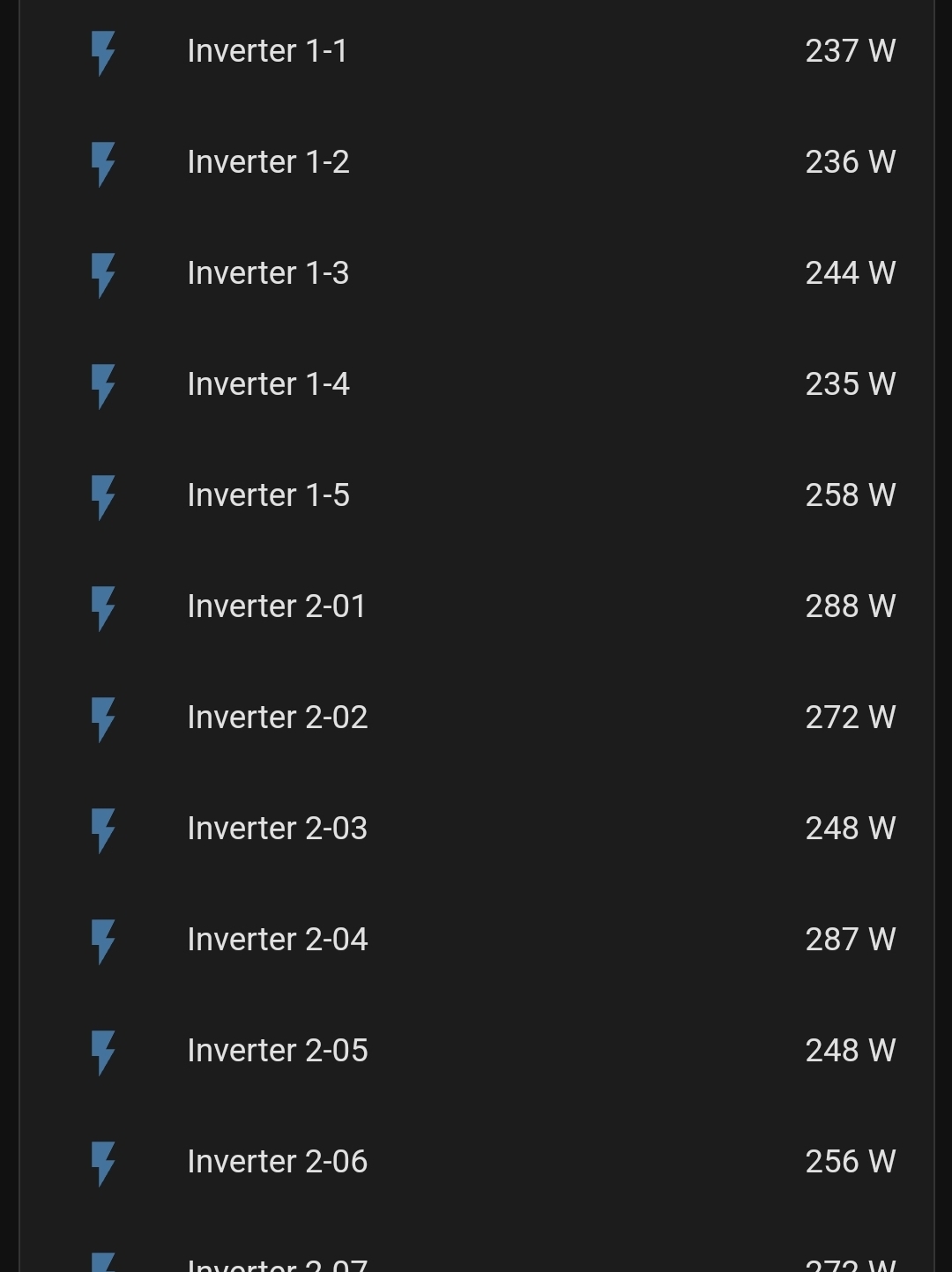
If your installer installs the consumption CTs (optional but the good installers usually include them for free), you’ll also have data on total power consumption for your house. It works really well with Home Assistant’s built-in energy dashboard.
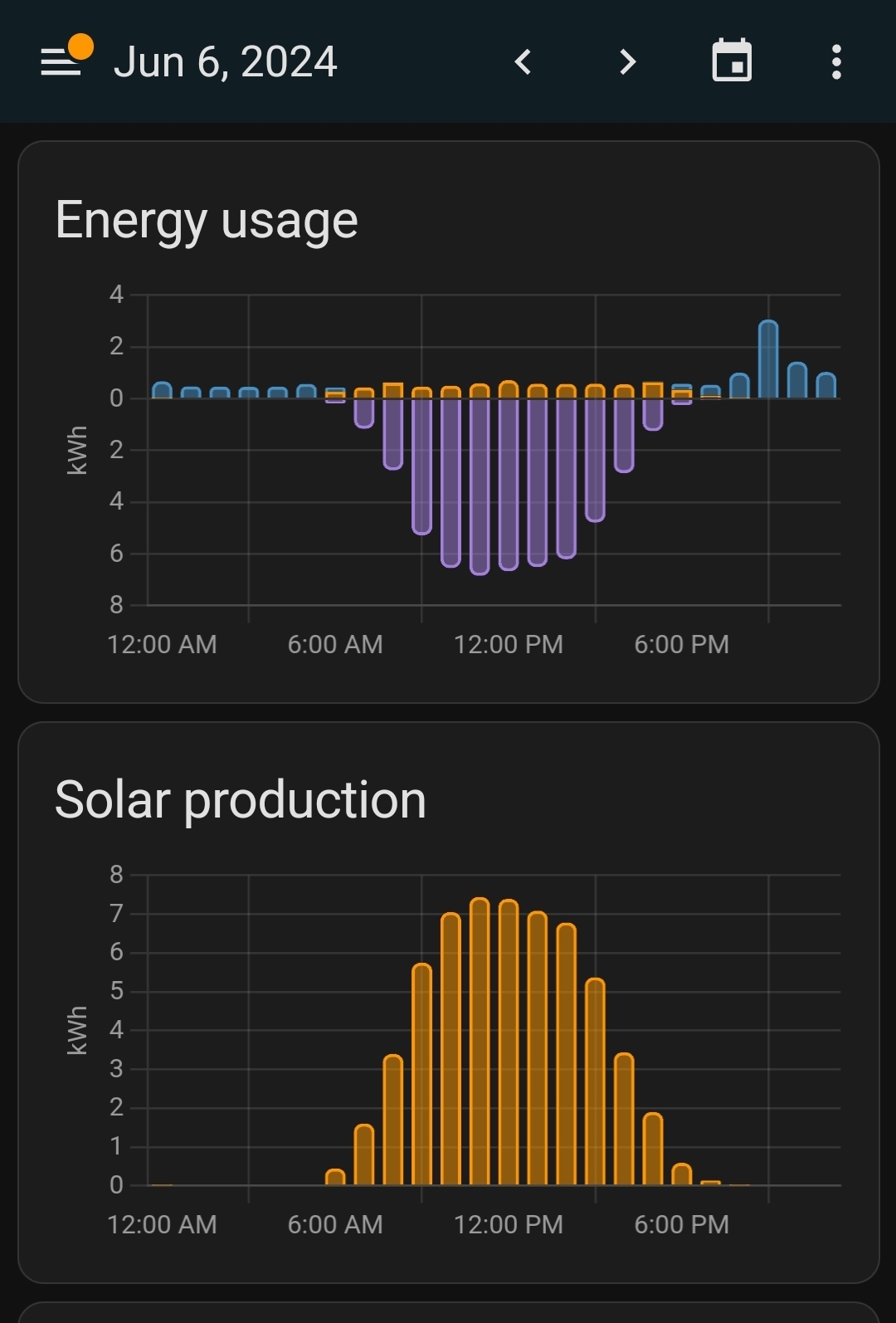
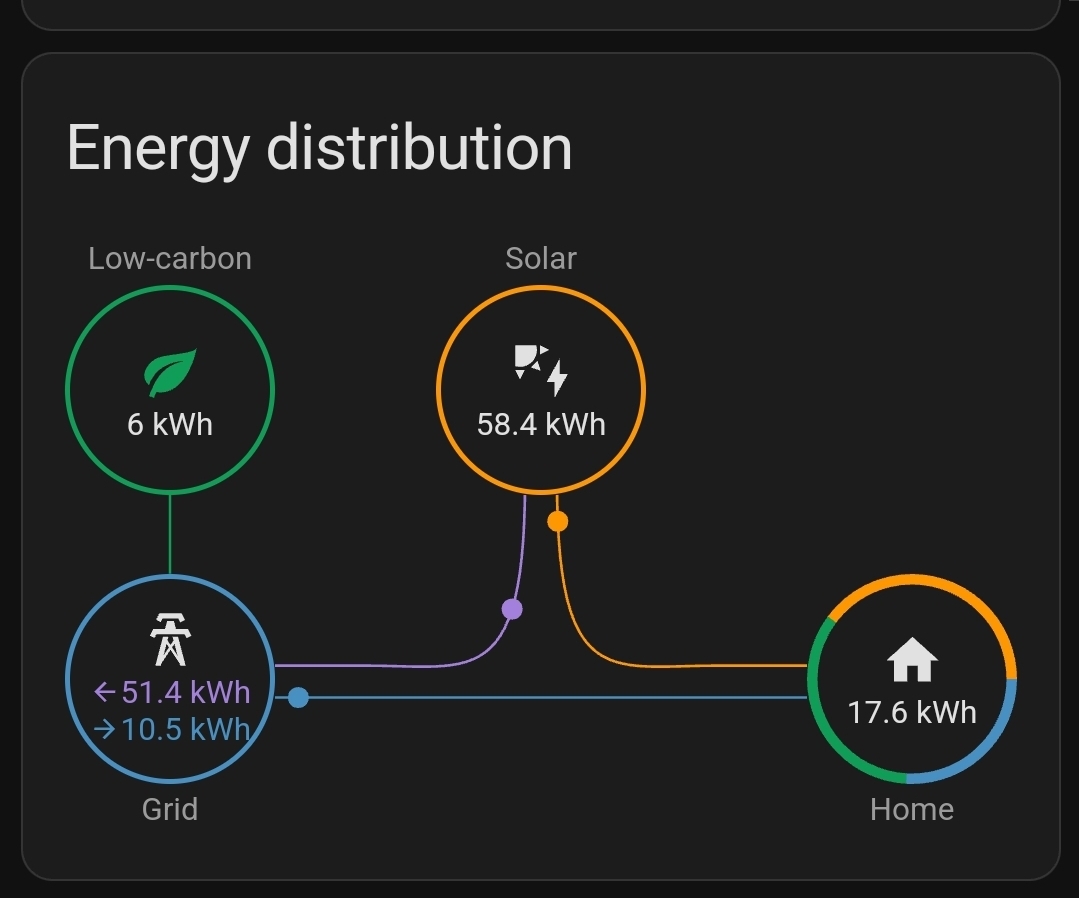
Dan you sound like a rad dude ad I’d love to have a beer with you
Hah, thanks (if you’re serious)! Feel free to DM me if you’re ever in the San Francisco Bay Area.
Removed by mod
Yeah I am. I like self hosting. I might add some friends to my server at some point.
I’m an Aussie living in the USA. I’ve been living in the US for 11 years but I’m still Aussie at heart. I’m still eligible for .au domains since I’m an Australian citizen.
Removed by mod
Newer panels are generally much more efficient and produce more electricity compared to old panels.
The 80% after 25 years might be their warranty, my panels have a similar warranty on them. If they start producing less than 80% of their original output before 25 years, the manufacturer will replace them (or something like that).
Yes, I’m looking at the paperwork and I’m realizing that you’re right, 80% at 25 is the warranty guarantee, so I’m guessing they’re confident it’ll typically be much better than 80 at 25
Or that they were expecting to be out of business by then…
The warranty is provided by the manufacturer of the solar panels, not by the installer. If your installer goes out of business, you can claim the warranty via another installer.
Of course, it’s possible the manufacturer will go out of business or sell their business.
yeh, thats what I mean, who knows what the state of the market will be in 25 years, unless its an insurance backed guarantee, be very suspicious of it.
For what it’s worth, a lot of the major manufacturers (QCell, REC, Canadian Solar) have been in business since the late 90s or early 2000s. SunPower (now Maxeon) has been around since 1985.
It’s a very conservative estimate, as manufacturers really don’t want to deal with warranty claims.
One part of solar system design is often to undersize the inverter a bit, so you might not see any degradation in the first few years at all. The logic there is that the electricity lost to clipping during peak times of the year doesn’t make up for the higher cost of a larger inverter.
Try to avoid SolarEdge inverters if you can. Enphase is really good and has a local API (so you can pull data into Home Assistant and other apps without going via the cloud) with a bunch of data, including per-panel production. Fronius and SMA are good too. Everyone I know with SolarEdge inverters has had issues with them though.
Any thoughts on a set of APsystems DSL3-L inverters? That’s what I’m quoted for. I’m in Canada so no idea what the inverter market is here
Never heard of them so I’m not sure, sorry!
This is amazing, because I do have HA running and I do want to pull data. I’ll look into what their plan is to see if I can make any last minute adjustments.
Assuming data is sent in the clear over any medium which I can get a receiver for I think I’d be ok, I am planning on getting a software defined radio on my HA in the near future
For Enphase, the data is available via a HTTP API. The combiner box (their hardware that all the inverters connect to) connects to your network via wifi or Ethernet, and you can hit its IP directly.
Unfortunately it’s kinda-cloud-dependent these days. The API used to take a basic username and password, nice and simple. Now, you need to hit a cloud API to get an access token (and periodically refresh it). The API is entirely local once you have the access token though, and there’s no problem with polling the data once per second.
Probably like tire warranties: prorated for expected life, and not including installation cost
What’s not included in the article is how much additional power might be produced by replacing them with newer systems.
Sure but you also haven’t lost any of the power that wasn’t generated by them being dead/broken
Also I don’t think we’ve really run out of suitable space to install new panels. If that ever happens it might be worthwhile to replace them, but as you said we can otherwise just run them alongside new installations until they break or maintenance costs surpass their profits
A significant portion of the cost of solar, is the installation costs. There’s not much you can do about how much work goes into installing panels, and this will get more expensive over time as wages rise. A more efficient panel means less to install, bringing down that installation cost
I don’t yet have solar panels so am not sure what they’d do, but at least half of my south facing roof is always shaded. Is the remaining half the roof sufficient space? I don’t know, but panel size is critical.
What you are not considering is that silicon crystallisation and the PV panel manufacturing process in its entirety are very resource-intensive and energy-intensive. The longevity of solar panels is one of their core properties that contribute to their high degree of sustainability.
Fortunately and unfortunately, there have been so many changes and breakthroughs on solar power over the last 50 years that this doesn’t really tell us much about current technology.
This is gonna sound so dumb… But they had solar panels back then?!
Carter called for solar panels to be installed on the White House in 1979. Modern ones are probably way more efficient but they were definitely a thing.
Solar panels have also been used in space mission for a very long time. The first solar powered probe was Vanguard 1 in 1958
Jesus Christ. Look, back in the Stone Age when I went to school the coolest calculator was the TI-36 Solar. It was already that mundane.
Naturally, I used a non-solar Casio, because I wasn’t one of the cool nerds.
damn you just reminded me my mom bought a basic calculator with tiny solar panel 25 years ago : it is still working !
And then there are the calculators with fake solar cell windows
deleted by creator
Sounds like you should install double what you think you need. Reason? The panels will start losing efficiency over time and your electricity usage over time will do nothing but grow. That’s very common.
Dude.
Those panels lost only 20%, so far from half, in 32 years.
That’s impressive.
I didn’t say they lost half but they lost 20% so you need to have at least 120% today and then you need to account for the fact that you will get more electric devices in the future. How are you going to charge your electric car if you don’t have the electric to do it? So therefore you should probably double it.
deleted by creator
Sure, the usage hasn’t changed on average in about 20 years, but in the next 20 years, it’s definitely going to increase dramatically.
Curious, which of our equipment will need more energy? Do you mean electric vehicles?
Yes, if the vast majority of cars are going to be electric in 20 years, you are definitely going to need a lot more power in order to charge them.
Then let’s get some vehicle-to-grid adoption going and make EVs a net benefit for spreading load better.





















